Australian rugby’s governance structure is under review with both New South Wales and Queensland’s current voting powers set to be knee-capped in favour of a ‘one vote one value’ system across all states. This mightn’t be a bad thing, but when you consider the potential it has to concentrate the ARU’s control over the game, this mightn’t be a good thing either.
The review will by headed by disgraced former Labor Senator, Mark ‘The Faceless Man’ Arbib and the chairman of the ARU’s governance committee, Peter Cosgrove. Indeed it was Cosgrove who boldly claimed that rugby’s decision making should no longer be controlled “by old men in blazers”, however; it is the blazer wearers at the ARU who will set the terms of the review.

As with most things ARU, the announcement was well and truly telegraphed in the press with both the SMH and The Australian newspapers carrying stories with substantial amounts of detail even though the review had yet to be announced.
What a delicious irony that a review into the ARU’s governance, scheduled to be announced at the AGM, should be leaked to the press before it was announced.
According to reports, the reason for the review is to bring rugby’s antiquated governance arrangements kicking and screaming into the 21st century so they comply with the Australian Sports Commission’s (ASC) Sports Governance Principles.
As it currently stands, New South Wales and Queensland have 5 and 3 votes at the AGM respectively, and both NSW and Qld can appoint two directors each to the Board.
The proposed changes would see each state having just one vote at the AGM and the Board being composed entirely of independent directors selected by the ARU.
Clearly singing from the ARU hymn sheet, both the SMH and The Australian were at pains to point out that these changes were necessary otherwise federal government funding was at risk of being rescinded.
But, me being a nerd with too much time on his hands, decided to have a quick read of the ASC’s Governance Principles and found that this is not necessarily the case.
Under Principle 1.4, the ASC makes it clear that while its preference for federated sports bodies is for “one state one vote ……a proportional voting system is an option.”
Principle 1.4 also states that “larger member bodies should never be able to dominate the direction of an organisation” but under the current ARU arrangements any decisions require a voting majority of 75% which individually, neither NSW or Qld are capable of.
Of far greater concern to compliance under the current ARU structure is Principle 1.5 that states, “the governance structure should feature a clear separation of powers and responsibilities between the board and the chief executive officer and their staff”.
Hang on, you mean the ASC is saying the CEO shouldn’t be a member of the board? I wonder how the fact that John O’Neill is both CEO and Managing Director managed to sneak between the bat and pad of the SMH’s and The Australian’s journalistic integrity?
It’s not just NSW and Qld that look set to have their influence eroded. Without question the Rugby Union Player’s Association should also be looking over its shoulder as well.

Currently RUPA has representation on the ARU’s board but according to Principle 1.8, it looks as though this representation is for the high jump. This Principle states that directors “are not appointed to represent any constituent body” and further that directors should have “no material conflict of interest as a result of being appointed director”.
Principle 1.8 then goes on to outline potential “material conflicts” and states that representatives of select groups would pose a “material conflict”. The guidelines give the example of a select group as being “umpires” so it’s not too much of a stretch to say “‘players”’ would fall into this category.
As an aside, Principle 1.8 also states that a CEO being a member of a board would also constitute a “material conflict” – so there’s strike two against JO’N’s current set up of him being CEO and MD. Just for completeness, strike three against having a CEO as a Director is mentioned at Principle 1.13 –– but hey, who’s counting!
While the “one state one vote” doctrine proposed might seem harmless enough, there are some significant threats to the independence of the smaller unions through financial incentives that can be offered by the ARU.
The ARU’s latest annual report shows that most of the smaller states owe the ARU money with amounts varying from $17,000 (Tasmanian RU) to a sizeable $427,000 (ACTRU).
It should be noted that the QRU is shown as a debtor in the ARU’s books but has since indicated it will pay this loan in full, and the NSWRU is not listed as a debtor.
While it’s totally appropriate for the ARU to help out the smaller states financially, it represents a risk that the ARU could use this financial hold to influence votes at the AGM.
Think I’m wrong? Well during 2011 the ARU totally extinguished the debt owed to it by the South Australian Rugby Union ($41,360) with no mention as to why, in either the SARU’s or ARU’s annual report.
Sure, $41,360 is not a massive figure in itself, but when you consider the SARU finished 2011 with only $168,679 in the bank, it represents a pretty big win for the SARU.
Obviously, as the amount of debt grows, so does the potential threat to independence. The fact the ARU still has provision for a further $124,000 in debt to write off suggests there could be more to come. I bet the ACTRU wouldn’t mind a bit of ARU largesse.
Of all the ASC’s principles, it’s Principle 1.7 that is my particular favourite. It states that “the board should evaluate the performance and determine the remuneration of the chief executive officer.”
This might prevent the extraordinary situation where the CEO receives bonus payments when both the Profit and Loss and Cash Flow Statements are full of red ink.
For the 2011 calendar year the ARU recorded a net operating loss of $7.522 million and saw its cash balance reduced by $15.843 million but this still didn’t stop JO’N taking home $180,000 in bonuses.
Bonuses for what you might ask? I’m not sure either, but it clearly wasn’t contingent on turning profit or World Cup success.
Gary Flowers produced similar financial results and was condemned, but out-going ARU Chairman, Peter McGrath, was glowing in his praise of JO’N.

“Credit must go to ARU Managing Director and CEO,John O’Neill and his management team for reducing the impact on the bottom line and achieving a deficit of just $7.5 million,” Mr McGrath said.
No, I’m serious, he really said that!!
Just imagine how much JO’N would rake it if it were a good year? I guess we’ll all get to see in the 2013 Annual Report after the sugar-hit in revenue a British and Irish Lions tour will bring.
Let’s hope the board is strong and recognise this. Oh, wait, that’s right, JO’N’s the Managing Director too! Oh well, next year’s annual report will make interesting reading all the same.
The sad thing about this whole situation is that the ARU has form when it comes to conducting reviews to justify a position or previous decision, and that simply isn’t governance.
With real governance comes transparency, and it is transparency that is the ARU’s biggest weakness. You only have to look at the debacle that surrounded the announcement of the Melbourne Rebels or the re-appointment of Robbie Deans to see the opaque nature of Australian rugby’s governing body.
It will be interesting to see who the winners and losers are out of this review. A betting man would think the ARU will be the ones singing the victory song but the real measure of success will be the benefit or otherwise to the game as a whole.


